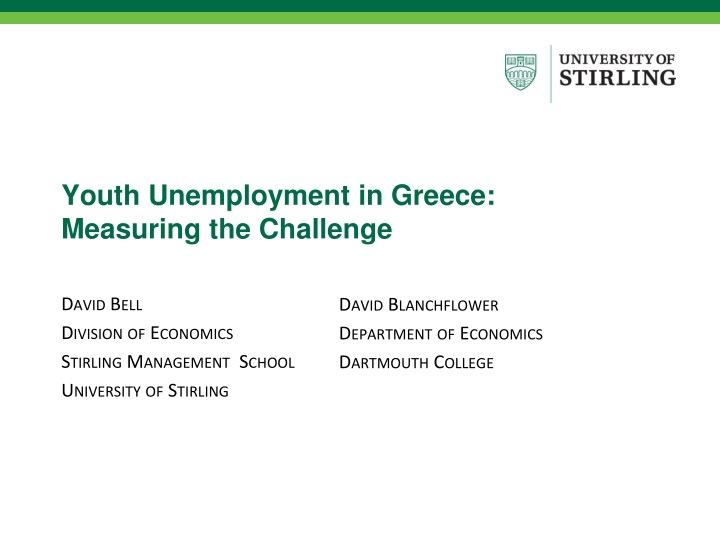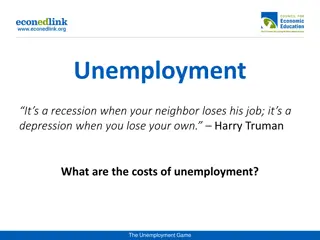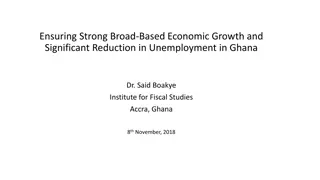Youth Unemployment in Greece: Measuring the Challenge
Youth unemployment poses a significant challenge in Europe, with Greece being a focal point. Policy responses such as the Youth Guarantee aim to provide employment, education, or training opportunities for young individuals. Evaluating the effectiveness of interventions to mitigate negative effects of youth unemployment is crucial, considering scarring effects on individuals' long-term labor market experiences.
Download Presentation

Please find below an Image/Link to download the presentation.
The content on the website is provided AS IS for your information and personal use only. It may not be sold, licensed, or shared on other websites without obtaining consent from the author.If you encounter any issues during the download, it is possible that the publisher has removed the file from their server.
You are allowed to download the files provided on this website for personal or commercial use, subject to the condition that they are used lawfully. All files are the property of their respective owners.
The content on the website is provided AS IS for your information and personal use only. It may not be sold, licensed, or shared on other websites without obtaining consent from the author.
E N D
Presentation Transcript
Youth Unemployment in Greece: Measuring the Challenge DAVID BELL DIVISION OF ECONOMICS STIRLING MANAGEMENT SCHOOL UNIVERSITY OF STIRLING DAVID BLANCHFLOWER DEPARTMENTOF ECONOMICS DARTMOUTH COLLEGE
A Deep-Rooted Problem [Youth unemployment is] "perhaps the most pressing problem facing Europe at the present time.... It is highly regrettable that parts of the economic elite assume so little responsibility for the deplorable situation Angela Merkel, July 2013
EU Policy Response The Youth Guarantee Member states of the European Union should "ensure that all young people under the age of 25 receive good quality offer of employment, continued education, apprenticeship or a traineeship with enough period of four months of becoming unemployed were leaving formal education." (Council of the European Union, 2013) The Council created the Youth Employment Initiative through which 6 billion will be made available to NUTS 2 regions with an youth unemployment rate above 25% in 2012. These monies have to be distributed between 2014 and 2016. The Youth Guarantee is intended to provide young people with a job, training or education over a defined period. The entitlement is generally given by public institutions such as the public employment service, sometimes acting in concert with private or third sector organizations.
Effectiveness of Interventions to Mitigate Negative Effects of Youth Unemployment Evidence of Success Limited Differences between countries in the types of programs, which succeed or fail Scaling up management problem Time horizon how long should evaluation last? (may have to rely on cohort studies or administrative data) Programs evolve complicating evaluations Evaluations tend to focus on narrow range of measures Understanding how allocation to programs may affect outcomes
Scarring Effects of Youth Unemployment Experience of unemployment when young A temporary disturbance that is part of the search and matching process for those inexperienced in the labour market A negative experience that changes the beliefs and preferences of the young about the nature of the labour market and has long-lasting negative effects on their labour market experience Most of the evidence supports the latter explanation
Greece and the Youth Guarantee Greece is intending to implement a national youth action plan using 517 million, with the aim of benefiting up to 350,000 young people. Measures under the plan include a temporary hiring program for unemployed persons below the age of 35 in community-based work programs. In July 2013 it introduced a youth internship and employment voucher program under the youth action plan aimed at supporting occasional training and internships for a six-month period for 45,000 people up to the age of 29. 1.2 billion is being allocated to help small and medium-sized companies meet liquidity requirements and so assist with the expansion of youth employment.
Analysis Using the European Labour Force Survey and Eurostat Comparators Spain and Portugal - southern European countries that, like Greece, have hit particularly hard by the recession The Republic of Ireland has also been hit hard, but has a quite different labor market Even though its economic performance has been much stronger, Sweden has experienced persistently high levels of youth unemployment Germany, the UK and France to give a perspective on unemployment trends in the European Union as a whole.
Greek Unemployment Rates by Age Group largest increase among 15-19 year olds 70% Ages 15-19 60% Ages 20-24 Ages 25-29 Greece had a substantial youth unemployment problem prior to the Great Recession 50% 40% 30% 20% 10% 0% 2005 2006 2007 2008 2009 2010 2011 2012
Greek Employment to Population Ratio by Age Group largest decline among 25-29 year olds 80% 70% Employment to Population Ratio Ages 15-19 60% Ages 20-24 50% Ages 25-29 40% 30% 20% 10% 0% 2005 2006 2007 2008 2009 2010 2011 2012
Rates can give a misleading impression of magnitudes Population Employment Unemployment Males Females Males Females Males Females Age 15-19 20-24 25-29 15-19 20-24 25-29 15-19 20-24 25-29 15-19 20-24 25-29 15-19 20-24 25-29 15-19 20-24 25-29 Year 2005 2009 2012 281 270 275 333 294 265 408 404 366 281 278 271 334 280 266 389 362 325 26 22 11 159 134 76 335 321 211 13 11 4 109 90 50 235 230 159 8 6 34 31 67 37 44 116 11 8 15 54 43 77 64 53 106 14 Activity Rate (%) EPOP Rate (%) Unemployment Rate (%) 2005 2009 2012 12 11 9 58 56 54 91 90 89 9 7 7 49 48 48 77 78 82 9 8 4 48 46 29 82 79 58 5 4 1 33 32 19 60 64 49 24 22 56 18 19 47 10 12 35 46 43 79 33 33 61 21 19 40
Table 3: Unemployment, NEET and Educational Status in selected European Countries among those aged 16-29, 2012 (000s) Portugal Spain Greece Non- student Non- student Non- student Student Total Student Total Student Total Employed 89 652 742 346 2,120 2,466 32 479 511 Unemployed 57 224 281 372 1,394 1,766 36 359 396 Inactive 681 94 776 2,674 519 3,193 729 131 860 Total 701 970 1,671 3,016 4,033 7,049 676 970 1,646 Unemployment Rate 38.8% 25.5% 27.4% 51.8% 39.7% 41.7% 53.5% 42.8% 43.6% NEET Rate 17.7% 25.8% 27.8% Germany France Sweden Non- student Non- student Non- student Student Total Student Total Student Total Employed 2,797 5,423 8,221 793 4,224 5,017 229 731 960 Unemployed 127 517 644 92 1,004 1,096 92 110 202 Inactive 4,646 863 5,509 4,208 885 5,093 582 93 675 Total 7,416 6,803 14,218 5,093 6,113 11,206 819 934 1,753 Unemployment Rate 4.3% 8.7% 7.3% 10.4% 19.2% 17.9% 28.7% 13.0% 17.4% NEET Rate 9.6% 16.9% 11.0%
Older NEETs pose a huge challenge for Greece Percent NEET (Not in Employment, Education or Training) by Country and Age Group 2013 40 35 30 Age 15-19 Age 20-24 Age 25-29 25 Percent NEET 20 15 10 5 0 Sweden Germany United KingdomPortugal FranceEuropean UnionIreland Spain Greece Source: Eurostat
Youth (16-24) to adult ratio is relatively low in Greece. 60.0 Greece 3.4 50.0 3.2 3.0 40.0 2.8 30.0 2.6 20.0 2.4 15-24/25-64 ratio (LHS) Youth unemployment rate (RHS) 10.0 2.2 2.0 0.0 Spain Sweden 3.3 30.0 2.3 60.0 15-24/25-64 ratio (LHS) 15-24/25-64 ratio (LHS) 3.1 Youth unemployment rate (RHS) 25.0 2.2 50.0 Youth unemployment rate (RHS) 2.9 2.7 20.0 2.1 40.0 2.5 15.0 2.0 30.0 2.3 2.1 10.0 1.9 20.0 1.9 1.8 10.0 5.0 1.7 1.7 0.0 1.5 0.0 1963 1965 1967 1969 1971 1973 1975 1977 1979 1981 1983 1985 1987 1989 1991 1993 1995 1997 1999 2001 2003 2005 2007 2009 2011
Youth cohort has been declining very rapidly in Greece 120 120 110 110 Greece Spain 100 100 90 90 80 80 70 70 60 50 60 2018 2000 2002 2004 2006 2008 2010 2012 2014 2016 2020 2000 2002 2004 2006 2008 2010 2012 2014 2016 2018 2020 120 110 100 UK 90 80 70 60 2008 2000 2002 2004 2006 2010 2012 2014 2016 2018 2020
Gender differences? 250% Greece Sweden Ireland Spain UK Portugal France Germany Ratio of Female to Male Youth 200% Unemployment Rates 150% 100% 50% 0% 2005 2006 2007 2008 2009 2010 2011 2012
How does staying at home influence labour market outcomes? Table 4: Proportion of those aged 15-29 with parents not in the same household Ages 15-19 Greece Total Males Females 2005 7.5 6.3 8.8 2006 6.8 5.6 7.9 2007 6.8 5.6 8.0 2008 6.8 6.0 7.5 2009 7.1 6.0 8.2 2010 6.3 5.2 7.5 2011 6.7 6.0 7.5 2012 6.2 5.4 7.1 Source: European Labor Force Survey Ages 20-24 Greece Males 26.8 25.3 28.5 30.4 32.3 28.2 25.6 27.7 Ages 25-29 Males 31.2 29.4 29.4 30.4 33.0 32.3 31.9 30.0 UK Total 7.9 7.3 7.3 8.5 8.5 8.9 8.3 8.4 UK Total 49.9 48.6 49.7 48.6 47.4 47.2 50.1 45.7 UK Total 81.0 81.3 80.5 79.7 78.5 78.4 81.1 79.5 Total 31.0 30.1 31.6 33.6 36.1 33.0 30.5 30.0 Females 35.1 35.1 34.8 37.0 40.0 37.8 35.3 32.3 Total 41.7 39.9 38.3 38.0 40.5 41.4 39.3 36.2 Females 52.6 51.3 48.1 46.2 48.9 51.1 47.4 43.3
The Role of Education Change 2005-08 to 2009-2012 Share of Cohort Employment Unemployment Inactivity No formal qualifications -4.0% 11.5% -7.5% 0.7% -11.6% 7.4% 4.2% 6.9% Primary -6.5% 2.0% 4.5% 25.7% Lower Secondary -11.9% 10.1% 1.8% 2.9% Upper Secondary Upper Secondary with quals Non-tertiary post- sec -6.7% 5.1% 1.6% 39.5% -12.5% 11.3% 1.2% 7.5% -8.3% 10.7% -2.4% 16.6% First stage tertiary Second stage tertiary 7.7% 0.1% -7.7% 0.1%
Long-term unemployment Greece had a substantial long- term unemployment problem prior to the Great Recession Germany Spain 60% France Greece Percent of Unemployed with duration > 12 months Ireland Portugal 50% Sweden UK 40% 30% 20% 10% 0% 2005 2006 2007 2008 2009 2010 2011 2012
Long-term Unemployment in Greece The average age of the long-term unemployed is lower in Greece than in our comparator countries with the exception of the UK and Ireland 0.20 Probability compared with 16- Long-term unemployment Unemployment 0.15 0.10 Conditional probability of (lt) unemployment by age 19 year old 0.05 0.00 -0.05 -0.10 Among our comparator countries Greece has the highest proportion of females among the long-term unemployed Other Sources of Variation in Long-term Unemployment Education Nationality
Amongst our group of countries, Greece experienced the largest fall in well-being with the recession But it was not concentrated among the young 2000-07 Age Group 25-29 2.8 2.89 3 3.09 3.16 3.21 3.37 2008-2012 Age Group 25-29 2.51 3 2.97 2.88 3.22 3.15 3.42 Changes 2000-2007 to 2008-2012 Age Group 15-24 25-29 -0.21 -0.29 -0.32 -0.32 0.2 0.11 0.12 -0.03 -0.08 -0.21 -0.16 -0.16 0.14 0.06 -0.02 -0.06 -0.01 -0.01 0.16 0.05 All 15-24 2.89 30+ 2.59 2.9 2.9 3.01 3.2 3.25 3.36 All 2.66 2.9 2.93 3.04 3.19 3.24 3.36 15-24 2.68 3.1 3.14 3.07 3.33 3.23 3.52 30+ 2.27 3.01 2.92 2.85 3.26 3.24 3.45 All 2.34 3.02 2.95 2.88 3.26 3.23 3.46 30+ Greece Germany 2.9 France Spain UK Ireland Sweden 0.11 0.02 0.12 0.02 3.02 3.15 3.19 3.25 3.36 0.06 0.07 0.09 0.1 Source: Eurobarometer
Conclusion In general, the evidence that ALMPs work is not strong. Careful evaluation in the correct context is essential. The age group 25-29 in Greece is probably of greatest concern Student (part-time) employment and unemployment is less common in Greece than in other European countries The European Labor Force Survey indicates that numbers in Greece in the 15-29 age group have fallen sharply Gender differentials in the Greek labor market are more marked than in many other EU states. Greek youths are much more likely to live at home than are young people in Northern Europe. Greece has the highest proportions of the young unemployed that have been without work for more than a year The decline in Greek well-being since the beginning of the recession has been the most rapid in Europe.
0 - Pre-primary education; 1- Primary education or first stage of basic education; 2- Lower secondary education or second stage of basic education; 3 - Upper secondary education; 4 - Post-secondary non-tertiary education; 5a - First stage of tertiary education (theoretical); 5b - First stage of tertiary education (technical, practical); shorter 6 - Second stage of tertiary























